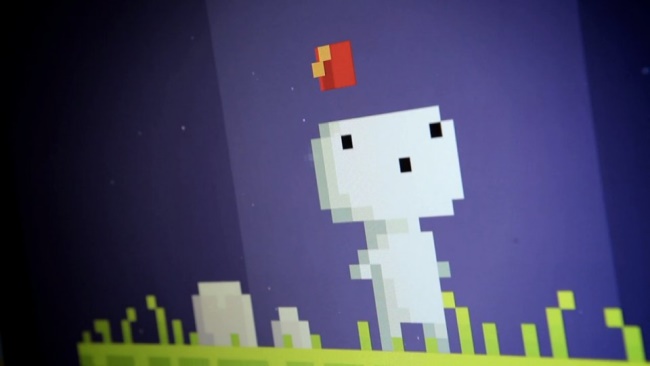The Glorious Lie of the Indie Bubble

Grab your laptops and head for the hills! The bursting of the great indie game bubble is upon us!
Surely by now you’ve heard about the surfeit of worthwhile games available on Steam and elsewhere, the Kickstarter fatigue that’s stricken gamers and thing-purchasers around the world, the mounting competition in terms of rising quality and sheer numbers, and the logic-defying, margin-erasing pay-what-you-want model of all the indie game bundles nowadays.
I mean, it’s clear from these factual observations that not only will there be not enough money to go around, but that some deserving games will get lost in the shuffle, right? Surely that state of affairs is tantamount to a massive bubble bursting!
Just picture it: One minute you’re happily game dev-ing away, minting thousands of dollars at a time, then BANG! Thick, viscous indie bubble juice everywhere!
But hold on – don’t break out those ponchos just yet. The idea of the indie bubble itself is more than just understandable paranoia in a world where change comes fast and the threat of disaster is a constant.
It’s also a fantastic opportunity to take a deeper look at the state of this indie thing of ours and discover, in detail, how indie game developers are going to fare in the years to come.
This Is Not the ‘80s
In the 1980s, the video game market crashed thanks to a spate of cheaply-produced, poor quality games churned out to suck as much money as possible from an unwitting populace taken with the novelty of the medium – only to be rescued by the coming of Nintendo’s flagship system and their fierce commitment to quality. This was a true games bubble, and when it popped, it almost took the entire industry with it.
Today’s indie scene could not be more different. What’s the main concern now? There are not only too many games, but from a developer’s point of view, the quality of the competition is getting too high! Far from exhausting consumers’ patience with our products, they can’t get enough of them because there is always something worthwhile to play.

But ah, of course – there’s that Kickstarter fatigue. Yet Kickstarted games show no sign of going away. If anything, Kickstarter fatigue is an observation about how the nature of crowdfunded games get covered in the press has changed.
What was once a novel press item about a random two-person operation in the middle of nowhere making a neat game has now come to be an accepted method of development. Of course, truly special games that warrant coverage will get it regardless of their funding models, as recent success stories can prove.
But the Steam sales, and Humble Bundles, and Indie Royales of the world – they’re driving down the price of games! Surely they aren’t innocent in perpetuating the indie bubble!
Again, look to recent history for perspective: In the old model of the ‘90s, you would spend anywhere from $40 to $70 on one of the few new releases that month, and proceed to play the crap out of it because A. the average game cost much more then than today, and B. since fewer games were released, it made sense to maximize every game’s replay value as much as possible.
Today, that model is also inverted. The amount of quality indie games that come out every month is so mind-boggling, and the average price is so much lower than in the ‘90s, that it makes total sense to buy a few and spread your gaming hours around. Plus, because modern titles generally take much less time to complete than ones from decades ago, gamers have more excuses for buying more games.
Far from this being a destructive trend – gamers literally have to spread their money around to more developers if they want to play everything worth playing!
Nay, I Say
“A lot of good titles won’t ever get that press. They just can’t. There’s not room… The gaming press knows that gamers only want to hear about so many indies. Soon, they’ll start picking who lives and who dies.”
–Jeff Vogel, from “Marketing, Dumb Luck, and the Popping of the Indie Bubble“
“Now hold on,” I can feel you naysayers thinking. “In Vogel’s piece, he talks about the ‘indie bubble’ mainly being a sharp decline in the amount of coverage the gaming press grants to indies. What if *this* changes? What then?”
Say this happened. What would gamers do? Would everyone go back to playing only console games and mainstream PC titles? Would IndieCade, the IGF, the Indie Fund, and all the indie-centric institutions that have been popping up just go away?
Or just maybe… indie-loving games writers would pick up the ball dropped by the IGNs and Gamespots of the world and create new game media sites that focused on niche games to meet an underserved market.
Maybe, this is what was put in motion years ago, and just maybe, it’s the direction that the industry as a whole is traveling in. Maybe what some people perceive as ‘the indie bubble’ is just a gradual re-orienting of the industry to a new normal, where individuals and small teams release games that do battle on the charts with multi-million dollar productions made by hundreds.
Harder, But Still Worth It
Is it hard to become a Hollywood screenwriter? Is it hard to get a book deal? Is it hard to become a professional musician? Yes, of course it is – but the people in charge of finding the next hit are always scouring the talent pool for the next thing to blow them away.
Just like how games writers are always looking for a great game to discover. Just like how gamers are always looking for the next game to thrill, delight, and move them like never before.
It is hard to be an indie game developer, and it will get harder. Better and easier tools are leveling the playing field, collaboration is easier than ever, and the quality of your competition will never stop rising.
That’s fine. Get used to it. Keep making, iterating, improving. But know that the world will always be hungry for amazing, personal experiences – the kind that indie developers do best.
